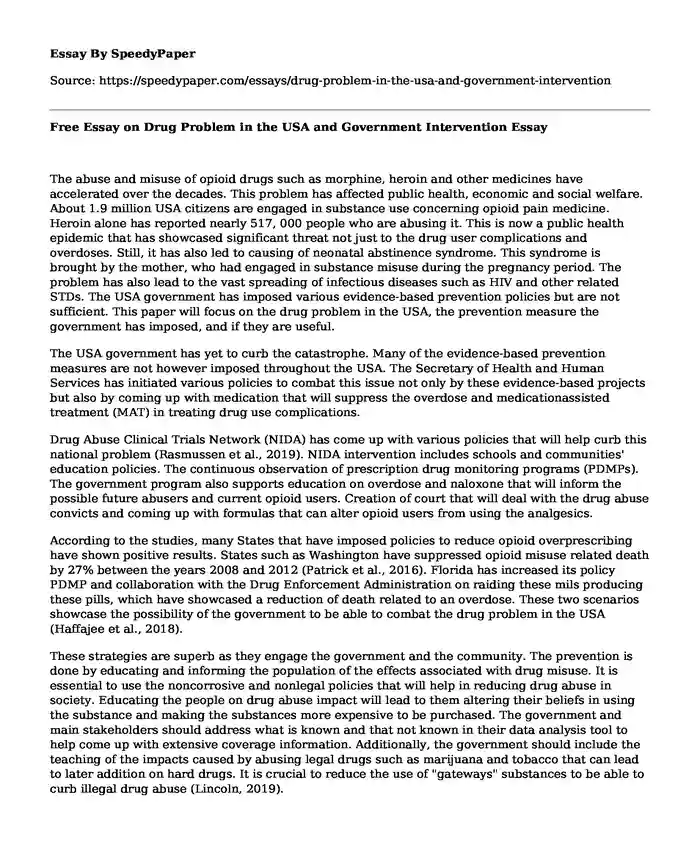
| Type of paper: | Term paper |
| Categories: | United States Criminal law Drug Substance abuse |
| Pages: | 3 |
| Wordcount: | 716 words |
The abuse and misuse of opioid drugs such as morphine, heroin and other medicines have accelerated over the decades. This problem has affected public health, economic and social welfare. About 1.9 million USA citizens are engaged in substance use concerning opioid pain medicine. Heroin alone has reported nearly 517, 000 people who are abusing it. This is now a public health epidemic that has showcased significant threat not just to the drug user complications and overdoses. Still, it has also led to causing of neonatal abstinence syndrome. This syndrome is brought by the mother, who had engaged in substance misuse during the pregnancy period. The problem has also lead to the vast spreading of infectious diseases such as HIV and other related STDs. The USA government has imposed various evidence-based prevention policies but are not sufficient. This paper will focus on the drug problem in the USA, the prevention measure the government has imposed, and if they are useful.
The USA government has yet to curb the catastrophe. Many of the evidence-based prevention measures are not however imposed throughout the USA. The Secretary of Health and Human Services has initiated various policies to combat this issue not only by these evidence-based projects but also by coming up with medication that will suppress the overdose and medicationassisted treatment (MAT) in treating drug use complications.
Drug Abuse Clinical Trials Network (NIDA) has come up with various policies that will help curb this national problem (Rasmussen et al., 2019). NIDA intervention includes schools and communities' education policies. The continuous observation of prescription drug monitoring programs (PDMPs). The government program also supports education on overdose and naloxone that will inform the possible future abusers and current opioid users. Creation of court that will deal with the drug abuse convicts and coming up with formulas that can alter opioid users from using the analgesics.
According to the studies, many States that have imposed policies to reduce opioid overprescribing have shown positive results. States such as Washington have suppressed opioid misuse related death by 27% between the years 2008 and 2012 (Patrick et al., 2016). Florida has increased its policy PDMP and collaboration with the Drug Enforcement Administration on raiding these mils producing these pills, which have showcased a reduction of death related to an overdose. These two scenarios showcase the possibility of the government to be able to combat the drug problem in the USA (Haffajee et al., 2018).
These strategies are superb as they engage the government and the community. The prevention is done by educating and informing the population of the effects associated with drug misuse. It is essential to use the noncorrosive and nonlegal policies that will help in reducing drug abuse in society. Educating the people on drug abuse impact will lead to them altering their beliefs in using the substance and making the substances more expensive to be purchased. The government and main stakeholders should address what is known and that not known in their data analysis tool to help come up with extensive coverage information. Additionally, the government should include the teaching of the impacts caused by abusing legal drugs such as marijuana and tobacco that can lead to later addition on hard drugs. It is crucial to reduce the use of "gateways" substances to be able to curb illegal drug abuse (Lincoln, 2019).
Opioid and other illegal drug use are on an accelerating point. However, the government has imposed various methods to curb and treat drug users' disorders. Some loopholes need to be taken care of. The government and the main stakeholder need to control the "gateways" drugs that will prevent future addition on hard drugs. Although the existing evidence-based approaches are effective, and many have shown positive outcomes.
References
Haffajee, R. L., Mello, M. M., Zhang, F., Zaslavsky, A. M., Larochelle, M. R., & Wharam, J. F. (2018). Four states with robust prescription drug monitoring programs reduced opioid dosages. Health Affairs, 37(6), 964-974.
Lincoln, G. (2019). An Overview of the Drug Epidemic in the United States with a Focus on Opioids, Cocaine, and Marijuana.
Patrick, S. W., Fry, C. E., Jones, T. F., & Buntin, M. B. (2016). Implementation of prescription drug monitoring programs associated with reductions in opioid-related death rates. Health Affairs, 35(7), 1324-1332.
Rasmussen, K., White, D. A., & Acri, J. B. (2019). NIDA's medication development priorities in response to the Opioid Crisis: ten most wanted. Neuropsychopharmacology, 44(4), 657.
Cite this page
Free Essay on Drug Problem in the USA and Government Intervention. (2023, Mar 05). Retrieved from https://speedypaper.net/essays/drug-problem-in-the-usa-and-government-intervention
Request Removal
If you are the original author of this essay and no longer wish to have it published on the SpeedyPaper website, please click below to request its removal:
- Free Essay Sample on Media Texts
- Criminal Law Essay about Legislature
- Healthcare Essay Sample: Interdisciplinary Teams Approach
- Global Forces and Advertising Industry, Free Essay
- Free Essay Analyzing the Article on Sleeping Pills
- Analysis Essay Sample on Mesopotamian Artworks: Saad Yagan
- Essay Example. Midterm Artifacts Reflection
Popular categories




